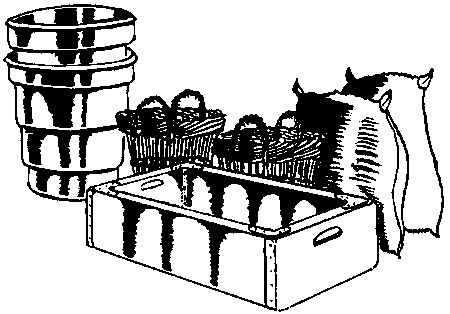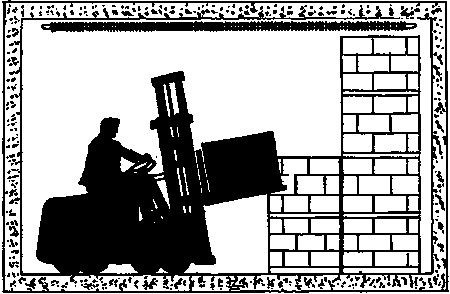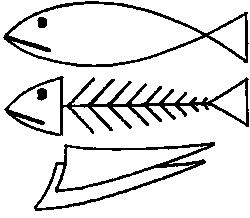Introduction
Measures of weight and volume
Densities and stowage rates
Physical composition of cod
Yields
This leaflet includes such miscellaneous information as definitions of some common units of measurement in the fishing industry, densities and stowage factors for a number of forms of fish, fish products and ice, and some conversion factors for yields of fish products from raw material.
Many of the figures given are approximate, since stowage rates and yields, for instance, depend upon, among other things, size and condition of the fish and the method of processing. In addition, information on many species and products is missing from this leaflet, either because Torry has no figures, or because the figures available are so unreliable that to record them would be misleading.

Units of measurement peculiar to the fishing industry are given in detail on the next page, but first it is necessary to set out the tables of British weights and measures that form the basis of commercial transactions:
|
Avoirdupois Weight |
||
|
16 ounces |
= |
1 pound |
|
14 pounds |
= |
1 stone |
|
28 pounds |
= |
1 quarter |
|
112 pounds |
= |
1 hundredweight (cwt) |
|
20 cwts |
= |
1 ton |
|
Capacity - Dry Measure |
||
|
20 ounces |
= |
1 pint |
|
2 pints |
= |
1 quart |
|
4 quarts |
= |
1 gallon |
|
2 gallons |
= |
1 peck |
|
4 pecks |
= |
1 bushel |
|
8 bushels |
= |
1 quarter |
Kit: (measure of weight) -
1 kit = 10 stones = 140 poundsThe 10-stone kit is a measure of weight in regular use at the quayside in Hull, Grimsby, Fleetwood and Lowestoft for the sale of white fish. Milford Haven uses 8- and 12-stone kits in addition to a 10-stone one for some species.
16 kits = 1 ton
The term ‘kit’ is also applied to other measures of weight ranging from 60 pounds to 12 stones that are used occasionally for certain species at some smaller ports, particularly in the West of England.
Cran: (measure of volume) -
1 cran = 37Herring are customarily sold in Britain by the cran. Under the Herring Industry Board’s minimum prices rules, and under Weights and Measures Regulations, all herring not sold by the cran must be sold by weight. A cran contains on average roughly 1,200 herrings, but this figure can vary widely with season and ground from 700 to 2,500 herrings for different fisheries. A cran measure is approximately equivalent to 28 stones of herring.gallons = 6·03 cubic feet
Basket: (measure of volume) -
As used at ports for the landing of herring.Box:
4 baskets = 1 cran (1 basket holds approx. 7 stones herring)
The box is used both as a measure of weight and as a measure of volume: at quayside sale it may contain anything from 5 to 10 stones of white fish at different ports. Aberdeen, for example, weighs its fish into 8-stone lots in boxes, whereas Granton lands fish unweighed in boxes said to contain approximately 6 stones. Most British ports now define the amount of fish being sold in boxes by declaring the contents either as a measured or as an estimated weight in stones and pounds.
Herring are often sold in boxes that reputedly contain a declared fraction of the cran unit of measurement. Any such sale must, however, be a sale by weight. Usual sizes of box are those that reputedly contain one-quarter or one-sixth of a cran; less common are boxes reputedly holding one-third or one-fifth of a cran.
Barrel: (measure of volume) -
Statutory obligation to make barrels in Scotland to a prescribed size was removed in 1963, and herring barrels can now be of any size: it is likely however that barrels of the following size will continue to be used for some time:
1 herring barrel = 26Used as a measure for pickle-salted herrings, the contents of a barrel will weigh about 320 pounds, and for Scotch cured herring will consist of about 700 to 1,100 fish depending on the selection. Roughly two-elevenths of the weight of the contents (58 pounds) is accounted for by salt and pickle, and nine-elevenths is fish (262 pounds).gallons
herring barrel = 13
gallons
The usual size of foreign barrel that is sometimes used in Britain holds about 100 kilos.
Bag: (measure of weight) -
For the sale of cockles and mussels in shell, a bag usually contains about 1 cwt of shellfish at most ports, but the contents can range from 7 to 10 stones depending upon the port and on whether or not the contents are weighed.
Bushel: (measure of volume) -
When used as a measure for the sale of sprats, a bushel contains about 56 pounds of fish.
Peck: (measure of volume) -
When used as a measure for shrimps, a peck contains about 10 to 14 pounds.

|
1. Fresh Fish |
Density |
Stowage Rate |
|
|
Chilled fresh fish muscle |
65·8 lb/ft3 |
|
|
|
Whole fresh herring in bulk |
58·2 “ |
38·5 ft3/ton |
|
|
Whole fresh mackerel in bulk |
50·0 “ |
45 “ |
|
|
Whole fresh sprats in bulk |
53·2 “ |
42 “ |
|
|
Whole fresh capelin in bulk |
62·5 lb/ft3 |
36 ft3/ton |
|
|
Whole fresh cod in bulk gutted |
57·5 “ |
39 “ |
|
|
|
(variable - depends on size of fish) |
||
|
Whole gutted fresh cod in bulk with ice |
49·5 lb mixture/ft3 |
45 ft3/ton mixture |
|
|
|
33 lb fish/ft3 |
68 ft3/ton fish = 4·25 ft3/kit |
|
|
Whole gutted fresh cod in bulk in ice (ratio as above) but including
allowance for fishroom structure |
32 lb fish/ft3 |
70 ft3/ton fish = 4·37 ft3/kit |
|
|
Whole gutted fresh cod stowed in single layers on ice on shelves 9 in.
apart (including allowance for structure) |
14 lb fish/ft3 |
160 ft3/ton fish = 10 ft3/kit |
|
|
Whole gutted fresh cod boxed in ice ( |
23 lb fish/ft3 |
96 ft3/ton fish = 6 ft3/kit * |
|
|
|
* (figure varies from 5·3 to 6·4 ft3/kit depending
on ratio of the effective volume to external volume of box) |
||
|
Fresh fillets in bulk |
60 lb/ft3 |
37 ft3/ton |
|
|
Fresh fillets, boxed with ice (enough ice for normal inland journey,
and including allowance for box) |
30 lb fish/ft3 |
75 ft3/ton fish |
|
|
Fresh fish livers, roes or milts in bulk |
62·5 lb/ft3 |
36 ft3/ton |
|
|
2. Frozen Fish |
|
|
|
|
Frozen whole gutted cod in large blocks - weight of fish within dimensions
of the block |
40 lb/ft3 (fish very loosely packed in block) |
||
|
|
55 lb/ft3 (very compact block) |
||
|
avg. |
48 lb/ft3 |
||
|
Frozen whole gutted cod in large blocks, including allowance for supporting
structure, access, etc. |
31 lb/ft3 |
72 ft3/ton fish = 4·5 ft3/kit |
|
|
Frozen fillets in large blocks |
55 to 60 lb/ft3 |
37 to 40 ft3/ton |
|
|
Frozen fillets in large blocks, including allowance for packaging, structure,
access, etc. |
40 to 50 lb/ft3 |
45 to 56 ft3/ton |
|
|
Frozen fillets or steaks in catering packs in master carton |
50 to 60 lb/ft3 |
37 to 45 ft3/ton |
|
|
Frozen fillets in consumer packs in master carton, with allowance for
pallets, access, etc. |
25 lb/ft3 |
90 ft3/ton |
|
|
Frozen fish sticks in retail packs |
25 to 30 lb/ft3 |
75 to 90 ft3/ton |
|
|
Frozen whole gutted cod, stowed as single fish |
25 to 30 lb/ft3 |
75 to 90 ft3/ton |
|
|
Frozen whole gutted halibut: |
|
|
|
|
|
in wooden boxes |
30 to 35 lb/ft3 |
65 to 75 ft3/ton |
|
stowed loose |
38 lb/ft3 |
59 ft3/ton |
|
|
Frozen whole salmon: |
|
|
|
|
|
stowed loose |
33 to 35 lb/ft3 |
65 to 68 ft3/ton |
|
in wooden boxes |
|
90 to 95 ft3/ton |
|
|
Frozen shelled shrimp in blocks |
45 to 55 lb/ft3 |
40 to 50 ft3/ton |
|
|
Frozen shelled shrimp in blocks, including allowance for packing structure,
etc. |
37 to 45 lb/ft3 |
50 to 60 ft3/ton |
|
|
Frozen breaded shrimp in consumer packs in master carton |
25 to 30 lb/ft3 |
75 to 90 ft3/ton |
|
|
3. Other Fish Products |
|
|
|
|
Fish liver oil |
58 lb/ft3 |
39 ft3/ton |
|
|
Fish meal, loose ground |
39 lb/ft3 |
58 ft3/ton |
|
|
Fish meal unground |
30 lb/ft3 |
75 ft3/ton |
|
|
Fish meal, bagged in 1 cwt bags stacked 10 high |
|
70 ft3/ton |
|
|
Crawfish, canned in cartons |
|
approx. 100 ft3/ton |
|
|
Dried cod in hundredweight bales |
37·5 lb/ft3 |
60 ft3/ton |
|
|
Dried fish in wooden boxes (181 lbs gross wt) |
|
100 ft3/ton |
|
|
Salmon salted in barrels |
|
45 to 50 ft3/ton |
|
|
Kippers in 1 stone wooden boxes |
31 lb/ft3 |
72 ft3/ton |
|
|
|
(approx. 24 pairs of average kippers = 1 stone) |
||
|
Salt fish: |
|
|
|
|
|
in bags (218 lbs gross wt) |
|
125 ft3/ton |
|
in wooden boxes (185 lbs gross wt) |
|
50 ft3/ton |
|
|
in casks (720 lbs gross wt) |
|
45 ft3/ton |
|
|
in kegs (90 lbs gross wt) |
|
55 ft3/ton |
|
|
4. Ice |
|
|
|
|
Solid ice at 32° F |
57·24 lb/ft3 |
|
|
|
Crushed block ice |
40 lb/ft3 |
56 ft3/ton |
|
|
Flake ice |
30 lb/ft3 |
75 ft3/ton |
|
|
Tube ice |
34 lb/ft3 |
66 ft3/ton |
|
Approximate weights of component parts of the body are given as percentages both of the whole ungutted fish and of the gutted fish. Weights of liver, guts, roe, etc., can fluctuate enormously with season, ground, condition of fish and so on; these figures can do no more than provide a very rough guide to yields after say heading, or heading and gutting, etc.
|
Component
|
Percentage |
Percentage |
|
||
|
whole weight |
gutted weight |
|
|||
|
range |
avg. |
range |
avg. |
|
|
|
Head |
|
21% |
|
25% |
|
|
Guts |
5-8% |
7% |
6-9% |
8% |
|
|
Liver |
2-7% |
5% |
3-8% |
5% |
- removed |
|
Roe |
1-7% |
4% |
1-8% |
5% |
|
|
Backbone, etc. |
|
14% |
|
17% |
|
|
Fins and lugs |
|
10% |
|
12% |
|
|
Skin |
|
3% |
|
4% |
|
|
Fillet, skinned |
|
36% |
|
42% |
|
|
|
|
100% |
|
100% + 18% guts and liver |
|

The following tables give figures for converting weight of whole fish to weight of fish product. The weight of whole fish is taken to be the weight as landed from iced stowage, that is gutted and with heads on, except for the following species, which are normally landed whole ungutted: herring, sprat, mackerel, pilchard, redfish, salmon, dogfish. It is assumed that filleting and processing are carried out to a good commercial standard.
1. Wet fillets:
To convert net landed weight of whole fish to equivalent weight as fillets:
|
Species |
Multiply landed weight by |
||
|
Fillets without skin |
Fillets with skin |
||
|
Cod |
0·42 |
0·47 |
|
|
Codling |
0·40 |
0·44 |
|
|
Haddock |
|
|
|
|
|
(large) |
0·42 |
0·47 |
|
(small) |
0·40 |
0·43 |
|
|
Whiting |
0·38 |
0·44 (block fillets) |
|
|
Hake |
0·50 |
0·55 |
|
|
Ling |
0·48 |
0·55 |
|
|
Plaice |
0·35 |
0·52 |
|
|
Lemon sole |
0·42 |
0·58 |
|
|
Catfish |
0·35 |
|
|
|
Redfish |
0·30 |
0·35 |
|
|
White fish generally |
0·43 |
0·47 |
|
|
Herring: |
|
|
|
|
|
immature |
|
0·57 |
|
spent |
|
0·55 |
|
|
up to |
|
0·58 |
|
|
|
|
0·54 |
|
|
|
|
0·51 |
|
|
|
ripe |
|
0·47 |
|
Herring generally |
|
0·53 |
|
To convert net landed weight of whole fish to equivalent as steaks:
|
Species |
Multiply landed weight by |
|
Salmon |
0·60 to 0·65 |
|
Halibut |
0·70 to 0·75 |
To convert net landed weight of whole fish to weight of smoked product:
|
Smoked product |
Multiply landed weight by |
|
Cod fillet |
0·32 to 0·35 |
|
Finnan haddock |
0·50 to 0·60 |
|
Golden cutlet |
0·25 to 0·30 |
|
Smokie |
0·45 to 0·50 |
|
Kipper |
0·65 to 0·70 |
|
Bloater |
0·68 to 0·80 |
|
Red herring |
0·60 to 0·62 |
|
Salmon sides |
0·45 to 0·60 (depends very much on weight of roe in
whole fish, and condition of fish). |
|
Mackerel, hot smoked whole gutted |
0·60 |
|
Eel, ditto |
0·65 to 0·75 |
To convert net landed weight of whole fish to equivalent weight of salted product:
|
Salted product |
Multiply landed weight by |
|
|
Dried salted split cod: |
||
|
|
light cure |
0·24 |
|
medium cure |
0·26 |
|
|
heavy cure |
0·34 |
|
|
Wet (Green) salted split cod: |
||
|
|
light cure |
0·60 |
|
medium cure |
0·56 |
|
|
heavy cure |
0·50 |
|
|
Herring: pickle cured |
0·79 to 0·88 (depends on ratio fish to salt in
barrel). |
To convert from net landed weight of whole fish to equivalent weight of frozen product:
|
Frozen product |
Multiply landed weight by |
|
|
Skinless cod fillet |
0·42 |
(Note: loss of weight during cold storage or during thawing is
ignored). |
|
Headless gutted cod |
0·75 |
|
|
Whole fish, all spp. |
1·00 |
|
|
Salmon steaks |
0·65 |
|
|
Steaks |
74·5% |
|
Bellies |
7·25% |
|
Tail chunks |
1·25% |
|
|
83% |
|
Sawdust |
4·5% |
|
Trimmings |
6·75% (nape, tail fin, etc.). |
|
Unaccounted for |
5·75% |
|
|
100% |
6. By-products:
To convert weight of white fish raw material to weight of fish meal, multiply by 0·21.
7. Edible portion of miscellaneous species:
For those species for which the equivalent weight as fillets is either not available or not appropriate, conversion factors are given for the weight of the edible portion from the landed weight of the fish.
|
Species |
Multiply landed weight by |
|
|
Salmon |
0·64 |
|
|
Sea trout |
0·63 |
|
|
Brown trout |
0·68 |
|
|
Eel |
0·50 to 0·60 |
|
|
Perch |
0·33 |
|
|
Pike |
0·43 |
|
|
Angler |
0·20 to 0·25 (meat only) |
|
|
|
0·33 (skinned tail) |
|
|
Gurnard |
0·40 |
|
|
Skate, ray, as wings |
0·45 |
|
|
Dogfish |
0·35 to 0·45 |
|
|
Conger |
0·50 |
|
|
Crab |
0·27 to 0·36 |
|
|
Lobster |
0·44 |
|
|
Norway lobster |
|
|
|
|
whole |
0·20 to 0·27 |
|
unshelled tails |
0·54 to 0·61 |
|
|
Shrimp, brown |
0·30 to 0·40 |
|
|
Prawn |
0·4 |
|
|
Oyster |
0·11 to 0·17 |
|
|
Cockle |
0·08 to 0·15 |
|
|
Winkle |
0·23 |
|
|
Scallop |
0·10 to 0·18 |
|
|
Mussel |
0·08 to 0·20 |
|
|
Whelk |
0·42 |
|